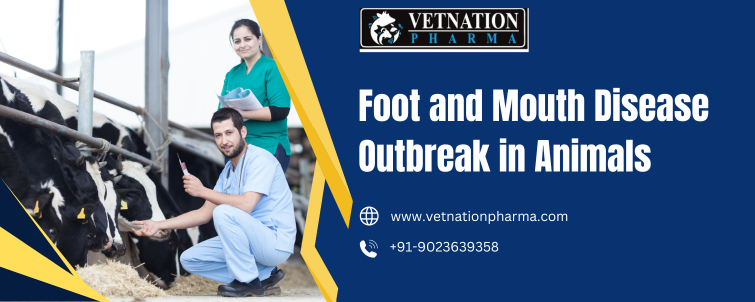- Veterinary PCD & Third Party Manufacturing
- +91-9023639358
- vetnationpharma@gmail.com
Foot and Mouth Disease Outbreak in Animals
Foot and Mouth Disease Outbreak in Animals : Vetnation Pharma
Foot and Mouth Disease Outbreak in Animals (FMD) is a highly contagious viral disease that affects cloven-hoofed animals, including cattle, pigs, sheep, goats, and deer. Outbreaks of FMD can have devastating effects on livestock populations and the agricultural economy. This article delves into the causes, impact, and control measures of FMD to provide a comprehensive understanding of this critical animal health issue.
Causes and Transmission of Foot and Mouth Disease
FMD is caused by the Foot and Mouth Disease Outbreak in Animals Virus which belongs to the genus Aphthovirus within the family Picornaviridae. The virus has seven serotypes: O, A, C, SAT1, SAT2, SAT3, and Asia1, with multiple strains within each serotype. The disease spreads rapidly through direct contact with infected animals or indirectly through contaminated materials.
Transmission Routes:
- Direct Contact: Animals can contract FMD through direct contact with infected saliva, mucus, milk, and feces.
- Indirect Contact: The virus can be spread via contaminated equipment, vehicles, clothing, and feed.
- Airborne Transmission: FMDV can become airborne and infect animals over long distances, particularly in favorable environmental conditions.
- Carrier Animals: Some animals can become carriers and shed the virus without showing clinical signs, contributing to the disease spread.
Symptoms and Diagnosis
FMD primarily affects the mouth and feet of infected animals, causing lesions and lameness. Symptoms vary between species and can appear as early as 2 to 14 days after exposure.
Common Symptoms:
- Fever: An initial rise in body temperature followed by a drop.
- Blisters: Vesicles and blisters on the tongue, lips, gums, nostrils, and between the hooves.
- Salivation: Excessive drooling due to mouth lesions.
- Lameness: Difficulty walking, reluctance to move, and hoof lesions.
- Reduced Milk Production: Dairy animals may show a significant drop in milk yield.
Diagnosis:
Accurate diagnosis of FMD involves clinical observation and laboratory tests. Techniques such as virus isolation, reverse transcription-polymerase chain reaction (RT-PCR), enzyme-linked immunosorbent assay (ELISA), and serological tests are commonly used to detect FMDV and confirm the presence of antibodies.
Impact of Foot and Mouth Disease Outbreaks
Foot and Mouth Disease Outbreak in Animals can lead to significant economic and social consequences:
- Economic Losses: The direct impact includes loss of livestock productivity, decreased milk production, weight loss in animals, and increased mortality rates. Indirect costs involve trade restrictions, culling of infected and at-risk animals, and expenditures on control measures.
- Trade Restrictions: Countries free of FMD impose strict import restrictions on livestock and animal products from affected regions, leading to substantial trade losses.
- Livelihoods: Smallholder farmers and rural communities heavily dependent on livestock suffer severe income losses and food insecurity.
- Animal Welfare: Infected animals experience significant pain and distress, raising ethical and welfare concerns.

Control and Prevention Measures
Effective control and prevention of Foot and Mouth Disease Outbreak in Animals require a multifaceted approach, involving strict biosecurity, vaccination, and rapid response strategies.
Biosecurity Measures:
- Quarantine: Immediate isolation of suspected and confirmed cases to prevent further spread.
- Movement Control: Restricting movement of animals, vehicles, and people within and between farms in affected areas.
- Disinfection: Regular cleaning and disinfection of premises, equipment, and transport vehicles to eliminate the virus.
Vaccination:
Vaccination plays a critical role in controlling Foot and Mouth Disease Outbreak in Animals. Vaccines are formulated based on the prevalent serotypes and strains in the region. Mass vaccination campaigns can help establish herd immunity and reduce the spread of the virus.
- Routine Vaccination: In endemic areas, regular vaccination of susceptible livestock is essential.
- Emergency Vaccination: During outbreaks, targeted vaccination of at-risk populations can help contain the virus.
Surveillance and Monitoring:
Continuous surveillance and monitoring are vital for early detection and prompt response to Foot and Mouth Disease Outbreak in Animals
- Active Surveillance: Regular testing and monitoring of livestock for early signs of FMD.
- Reporting Systems: Efficient reporting mechanisms to notify authorities of suspected cases immediately.
International Collaboration
Global cooperation and coordination are crucial in managing FMD. Organizations such as the World Organisation for Animal Health (OIE) and the Food and Agriculture Organization (FAO) play pivotal roles in facilitating international efforts to control and eradicate FMD through guidelines, support, and collaboration.
Conclusion: Foot and Mouth Disease Outbreak in Animals
Foot and Mouth Disease remains a significant threat to livestock health and the agricultural economy worldwide. Understanding its causes, transmission, and impact is essential for implementing effective control measures. By adopting stringent biosecurity practices, widespread vaccination, and robust surveillance systems, the spread of FMD can be mitigated, protecting animal health and securing livelihoods
Contact Information
Contact Vetnation Pharma if you want to know Foot and Mouth Disease Outbreak in Animals or any other part of PAN India.
- Company Name: Vetnation Pharma
- Company Address: Plot no 295, Industrial area phase -2, Panchkula- 134 109, Haryana (India)
- Contact us: +91- 90236 39358
- Website: www.vetnationpharma.com/
- Write us: vetnationpharma@gmail.com
